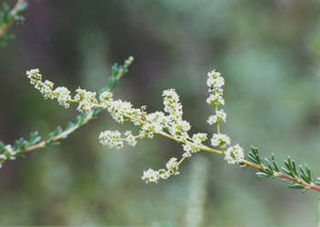
Baccharis is a genus of perennials and shrubs in the aster family (Asteraceae). They are commonly known as baccharises but sometimes referred to as "brooms", because many members have small thin leaves resembling the true brooms. They are not at all related to these however, but belong to an entirely different lineage of eudicots. B. halimifolia is commonly known as "groundsel bush", however true groundsels are found in the genus Senecio.

Adenostoma fasciculatum, commonly known as chamise or greasewood, is a flowering plant native to California and Baja California. This shrub is one of the most widespread plants of the California chaparral ecoregion. Chamise produces a specialized lignotuber underground and at the base of the stem, known as a burl, that allow it to resprout after fire has off burned its stems. It is noted for its greasy, resinous foliage, and its status as one of California's most iconic chaparral shrubs.

Calycoseris parryi, the yellow tackstem, is a spring wildflower found in the Mojave Desert, the Sonoran Desert, and surrounding regions of the southwestern United States and northwestern Mexico. It is found in California, Nevada, Utah, Arizona, and Baja California.

Baccharis pilularis, called coyote brush, chaparral broom, and bush baccharis, is a shrub in the family Asteraceae native to California, Oregon, Washington, and Baja California. There are reports of isolated populations in New Mexico, most likely introduced.

Ericameria nauseosa, commonly known as chamisa, rubber rabbitbrush, and gray rabbitbrush, is a shrub in the sunflower family (Aster) found in the arid regions of western North America.

Prunus fasciculata, also known as wild almond, desert almond, or desert peach is a spiny and woody shrub producing wild almonds, which is native to western deserts of North America.

Lepidospartum is a genus of North American desert shrubs in the daisy family. They are known commonly as broomsages or scalebrooms. These are tall, woody shrubs with stiff twiggy branches that resemble brooms. They are native to the southwestern United States and far northern Mexico. These shrub have thin, narrow, needlelike or scalelike leaves and bear yellow daisy flowers.

Chaenactis fremontii, with the common names Frémont's pincushion and desert pincushion, is a species of annual wildflower in the daisy family. Both the latter common name, and the specific epithet are chosen in honor of John C. Frémont.

Tiquilia canescens, the woody crinklemat or shrubby tiquilia, is a perennial, shrub in mid- to lower-elevation desert regions in the family Boraginaceae - Borage or the Forget-me-nots. It is found in the southwestern United States and Northwestern Mexico, in the states of California, Nevada, Arizona, Utah, New Mexico, Texas, Chihuahua, Sonora, and Baja California. It is a short, low-growing plant, seldom over 15 in tall.

Isocoma acradenia is a North American species of flowering plant in the family Asteraceae known by the common name alkali goldenbush.

Baccharis brachyphylla is a North American species of shrub in the family Asteraceae, known by the common name shortleaf baccharis or false willow. It is native to the southwestern United States and northern Mexico. It grows in desert habitats such as arroyos and canyons.

Baccharis sergiloides is a species of Baccharis known by the common name desert baccharis.

Ceanothus pauciflorus, known by the common name Mojave ceanothus, is a species of flowering shrub in the buckthorn family, Rhamnaceae. It is native to the Southwestern United States and Mexico, where it grows primarily in shrubland communities at moderate to high elevations. It is characterized by oppositely arranged leaves, corky stipules and white flowers. It was formerly known as Ceanothus greggii.

Rafinesquia neomexicana is a species of flowering plant in the family Asteraceae. Common names include desert chicory, plumeseed, or New Mexico plumeseed. It has white showy flowers, milky sap, and weak, zigzag stems, that may grow up through other shrubs for support. It is an annual plant found in dry climate areas of the southwestern deserts of the US and northwestern deserts of Mexico.

Quercus turbinella is a North American species of oak known by the common names shruboak, turbinella oak, shrub live oak, and gray oak. It is native to Arizona, California, New Mexico, Utah, Colorado, and Nevada in the western United States. It also occurs in northern Mexico.

Quercus oblongifolia, commonly known as the Mexican blue oak, Arizona blue oak, Blue live oak or Sonoran blue oak, is an evergreen small tree or large shrub in the white oak group.

Baccharis salicina is a species of plant in the family Asteraceae. Common names include willow baccharis, and Great Plains false willow. It is a shrub found in North America where it grows in mildly saline areas.

Greasewood is a common name shared by several plants:

Ambrosia salsola, commonly called cheesebush, winged ragweed, burrobush, white burrobrush, and desert pearl, is a species of perennial shrub in the family Asteraceae native to deserts of the southwestern United States and northwestern Mexico.

Ambrosia monogyra is a species of flowering plant in the sunflower family commonly known as the singlewhorl burrobrush, leafy burrobush, slender burrobush, and desert fragrance. Ambrosia monogyra is native to North America and is typically found in canyons, desert washes, and ravines throughout arid parts of the southwestern United States and northern Mexico. This species has green, threadlike leaves that emit a distinctive odor when crushed, and flowers from August to November. The fruits have distinctive wings in their middle that aid in dispersion through wind and water.




















